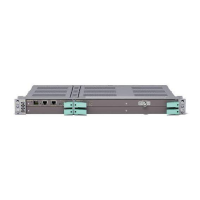Management
6.2 Configuration Management
The configuration can be managed locally and from the O&M center provided
that the DCN is set up. The following list gives examples of configuration areas:
• Transmission interface parameters
• Traffic routing
• Traffic protection, such as 1+1 E1 SNCP, MSP 1+1
• DCN parameters, such as host name, IP address
• Security parameters, such as enabling telnet, adding new SNMP users
• Radio Terminal parameters, such as frequency, output power, ATPC and
protection
6.3 Software Management
Software can be upgraded both locally and remotely. Software upgrade utilizes
a local or remote FTP server to distribute the software to the NE. An FTP
server is provided on the MINI-LINK Service Software CD used when installing
software on site.
The MINI-LINK TN R3 system software consists of different software modules
for different applications.
All traffic continues while the software is being loaded. During the execution of
the software download a progress indication is provided in the user interface.
When the download is completed, the new software and the previous software
version are stored on the unit.
Performing a warm restart of the NE activates the new software version. A
warm restart only affects the control system. This restart can be performed
immediately or scheduled at a later time. The restart, depending on the new
functionality, may influence the traffic. When the warm restart with the new
software is completed, the NE will wait for a “Commit” command from the
management system. When “Commit” is received, the software upgrade
process is completed.
The previous software revision remains stored on the unit in case a rollback is
required. This may be the case if something goes wrong during the software
upgrade or if no “Commit” is received within 15 minutes after the restart.
If plug-in units with old software versions are inserted into the NE, they can
be automatically upgraded.
109
4/1555-CSH 109 32/1-V1 Uen B 2007-09-14

